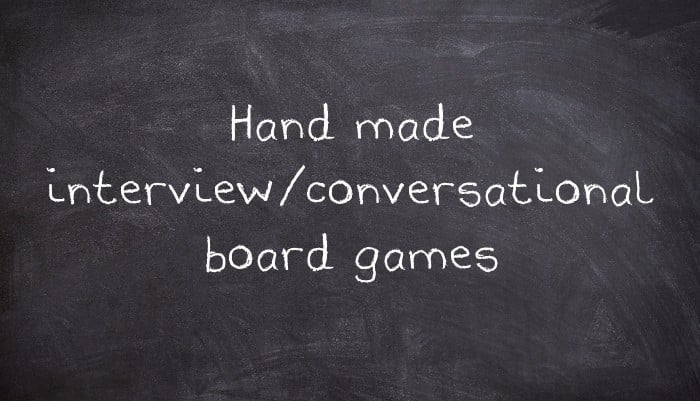I use hand-made interview/conversational board games to humanize my language teaching from a metadiscourse level to a personal one with my adult language students. I find this approach lends itself to private one-on-one instruction and to small groups of students. I find too that it's very appropriate for language learners who have studied English and have some grasp of the English language but are too shy, reluctant or afraid of speaking for fear of making a mistake.
There are many benefits. It serves as an informal way to assess your student(s) level(s) and a means to monitor progress. I found that using a structured interview process to assess my student's language ability and progress made them nervous. Despite my best efforts to put the student(s) at ease and re-assure them, they were nervous and I could see how their nervousness impacted their performance. I find that I can assess my student(s) comprehension, speech fluency (unnatural rhythm, hesitant, too slow), pronunciation (unnatural stress, sounds, adds vowels), grammar (strengths and weaknesses with verb tenses, plurals, prepositions, and articles), and vocabulary in a relaxed and casual way. Besides allowing you the opportunity to informally assess your student(s) language ability, it allows you to do remediation, review sentence patterns, verb tenses, polite English, slang, and so on within the context of playing a game.
The process provides the student(s) with an opportunity to get to know you within the context of playing. It places me in a new context. I am no longer the teacher standing at the front of the classroom, but a participant sitting at a table playing a game with my student(s). It really changes the dynamics and bridges the distance between teacher and student in a fun way. I find too it's also a way for me to show off my personality, enthusiasm, and love of teaching. I clap and cheer when my student(s) answers correctly. I'm supportive, encouraging and helpful when they are having difficulty. It's a means to demonstrate your metal.
I use a simple design to make my board games. There's a start and finish square and in between a number of squares that go along from the start square to the finish square. Each square is filled with a question. The pattern and length can vary. I use a simple square pattern that goes around the board. I'll leave the questions to your discretion but for illustration purposes, I am highlighting some questions I use for beginners. Here they are:
- What's your name?
- Where are you?
- Where do you live?
- What's your favourite colour?
- Do you like apples?
- Do you eat cheese?
- Do you drink milk?
- Where are you from?
- What's the time?
- How's the weather?
- When is your birthday?
- How are you?
- How tall are you?
- How do you go to work?
- How do you spell your first name?
- Are you married or single?
I also include commands such as point to the door, point to the teacher, open your book, stand up, sit down, and include spots for free questions which are marked with a question mark (?). The student or teacher can ask any question they like. Be prepared for some unusual questions coming from your students. You'll also need a die to play the game.
This is a simple approach to helping your language students become more fluent in their speaking and build their self-confidence. Give it a try. What do you have to lose? Perhaps, you might be pleasantly surprised by the positive results. I was.
